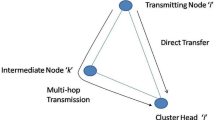Abstract
Wireless body area Networks is used to measure the ambient conditions related to the environment surrounding the sensors and transforms them into an electrical signal, which is transmitted to the sink and then processed further. The sensor nodes are constrained by energy supply and bandwidth and also there is a loss of data packets or intrusion of the data packets in the network. Various techniques have been proposed to improve the energy consumption rate, such as clustering, efficient routing, and data aggregation. In this paper, the clustering technique is used to reduce the energy and also Code Block Binding algorithm is used to secure the data that is sent to the sink for processing. The simulation results proved that the energy cost using the clustering based TDMA are reduced with security mechanism and the network lifetime is increased. Also, the CBB-TDMA algorithm is used which proved the PDR is 97% when compared to the other protocols which resulted only in 61% to 92%.




Similar content being viewed by others
References
Xu, Jiuqiang, Liu, Wei, Lang, Fenggao, Zhang, Yuanyuan, & Wang, Chenglong. (2010). Distance measurement model based on RSSI in WSN. Wireless Sensor Network, 2(08), 606.
Stemm, Mark, & Katz, Randy H. (1997). Measuring and reducing energy consumption of network interfaces in hand-held devices. IEICE Transactions on Communications, 80(8), 1125–1131.
He, Tian, Blum, Brian M., Stankovic, John A., & Abdelzaher, Tarek. (2004). AIDA: Adaptive application-independent data aggregation in wireless sensor networks. ACM Transactions on Embedded Computing Systems (TECS), 3(2), 426–457.
Thaskani, S. S., Kumar, K. V., & Murthy, G. R. (2011). Mobility tolerant TDMA based MAC protocol for WSN. In 2011 IEEE symposium on computers & informatics (ISCI) (pp. 515–519). IEEE.
Vuran, Mehmet C., & Akyildiz, Ian F. (2006). Spatial correlation-based collaborative medium access control in wireless sensor networks. IEEE/ACM Transactions on Networking (TON), 14(2), 316–329.
Li, Yiping, Zhang, Xiaotong, Zeng, Jun, Wan, Yadong, & Ma, Fuqiang. (2017). A distributed TDMA scheduling algorithm based on energy-topology factor in Internet of Things. IEEE Access, 5, 10757–10768.
Jiang, X., & Du, D. H. C. (2016). PTMAC: A prediction-based TDMA MAC protocol for reducing packet collisions in VANET. IEEE Transactions on Vehicular Technology, 65(11), 9209–9223.
Sabti, H. A., & Thiel, D. V. (2014). Node position effect on link reliability for body centric wireless network running applications. IEEE Sensors Journal, 14(8), 2687–2691.
Hadded, M., Muhlethaler, P., Laouiti, A., & Saidane, L. A. (2016). A centralized TDMA based scheduling algorithm for real-time communications in vehicular ad hoc networks. In 2016 24th International conference on software, telecommunications and computer networks (SoftCOM) (pp. 1–6). IEEE.
Kim, S., Fonseca, R., & Culler, D. (2004). Reliable transfer on wireless sensor networks. In 2004 First annual IEEE communications society conference on sensor and ad hoc communications and networks, 2004. IEEE SECON 2004 (pp. 449–459). IEEE.
Kanzaki, A., Uemukai, T., Hara, T., & Nishio, S. (2003). Dynamic TDMA slot assignment in ad hoc networks. In 17th International conference on advanced information networking and applications, 2003. AINA 2003 (pp. 330–335). IEEE.
Ray, S. S., Demirkol, I., & Heinzelman, W. (2009). ADV-MAC: Advertisement-based MAC protocol for wireless sensor networks. In 5th International conference on mobile ad-hoc and sensor networks, 2009. MSN’09 (pp. 265–272). IEEE.
Mustafa, M. M., Parthasarathy, V., Kumar, M. R., & Hemalatha, S. (2016). An efficient DTDM H-MAC protocol with self-calibrating algorithm in BSN for sporting application, 9(9), 4093–4102.
Hu, Chunqiang, Li, Hongjuan, Huo, Yan, Xiang, Tao, & Liao, Xiaofeng. (2016). Secure and efficient data communication protocol for wireless body area networks. IEEE Transactions on Multi-Scale Computing Systems, 2(2), 94–107.
Mustafa, M. M., & Parthasarathy, V. (2020). A design and implementation of polling TDMA with a comparative analysis with time division multiple access for sporting application. Wireless Networks, 26(3), 1897–1904.
Author information
Authors and Affiliations
Corresponding author
Additional information
Publisher's Note
Springer Nature remains neutral with regard to jurisdictional claims in published maps and institutional affiliations.
Rights and permissions
About this article
Cite this article
Mohammed Mustafa, M., Parthasarathy, V. A Clustering TDMA and Code Block Binding Algorithms to Enhance the Node Energy and Security of the Network. Wireless Pers Commun 116, 767–775 (2021). https://doi.org/10.1007/s11277-020-07737-w
Published:
Issue Date:
DOI: https://doi.org/10.1007/s11277-020-07737-w




